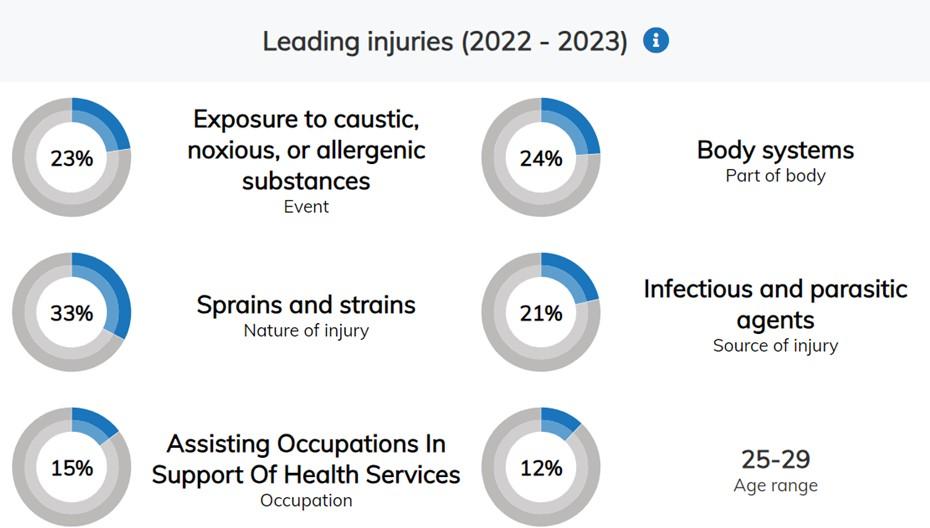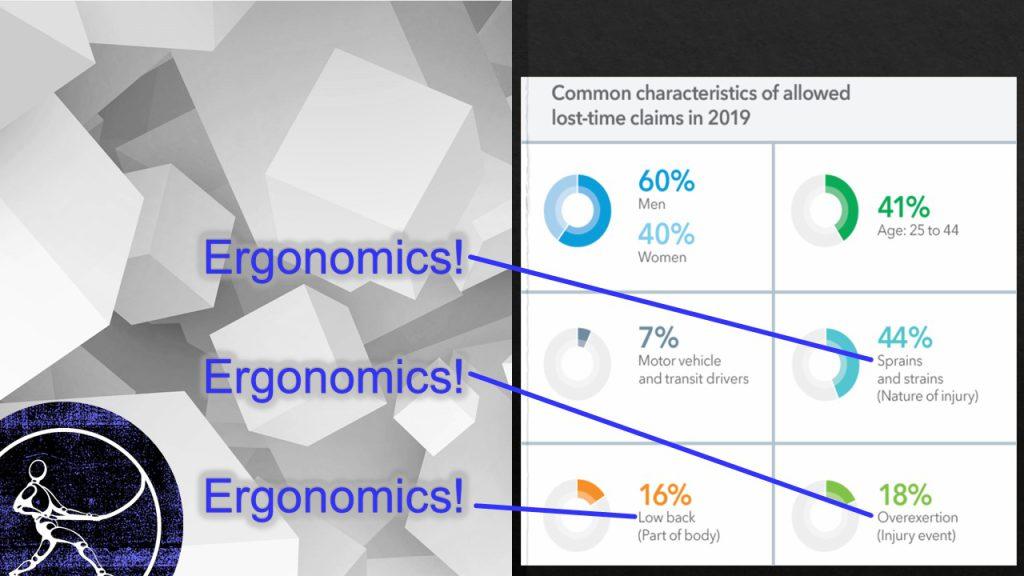“Ergonomics” means fitting work to people. An “ergonomic” issue in the workplace, therefore, is associated with work not fitting people. In some workplaces, work may exceed workers’ mental abilities, resulting in errors with potentially dire consequences. For most of our clients, an “ergonomic” issue means the work is beyond the worker’s physical capabilities. Let’s explore that further.
In Ontario, “ergonomics” is linked to the most common “nature of injury” (strains and sprains), and this was true even during the pandemic years. (Stats below from https://safetycheck.onlineservices.wsib.on.ca/safetycheck/explore/provincial/SH_12?lang=en.) During 2022/23, the “leading” injuries did lean toward COVID-19, with “body systems”, and “infectious agents” cropping up most often.

However, prior to COVID-19 and, presumably in the future when life returns to normal, poor ergonomics can be linked with every injury indicator:
- The most common NATURE of injury was “Strains and sprains”, at 44% of all injuries.
- The most common BODY PART injured was the lower back.
- The most common EVENT was overexertion.

So, back to the topic of today’s blog: What are the most common ergonomic issues? Strains and sprains occur when the demands of the job exceed the physical capabilities of the worker. The job is too heavy or forceful, too awkward, too repetitive, or too prolonged. And, more often than not, it’s some combination of effort, awkwardness, and exposure over time that creates injuries.
If you’re inspecting your workplace or interviewing workers to identify “ergonomic” hazards, look for tasks that require people to push, pull, lift or grip while in an awkward position, or tasks that require people to work in awkward positions repetitively or for long periods of time.
What’s an awkward position?
I’ve shown some images of “awkward” work positions at the top of this article. Bending to work at floor level with a grinder, working overhead under a vehicle, reaching and bending the wrists to type, and working above shoulder height with a sander are all examples of awkward working positions. People don’t generally get injured from doing these things once; injuries typically occur when they have to do them repetitively or with a lot of effort.
What’s a “lot” of effort?
For tasks that only happen occasionally, a worker can exert close to maximum effort. What is maximum effort? If you push, pull, lift or grip with every ounce of strength that you have, you’re using “maximum” effort. Ergonomists don’t want people to do that very often! As the task becomes more repetitive or sustained, how much effort you can safely exert is reduced. A very repetitive task can only be safely performed with relatively light efforts. It’s also worth noting that your maximum effort is less when you’re in an awkward position. If you can just barely lift a 100 lb box with handles from a table, you won’t be able to lift a 100 lb block of metal from a shelf over head.
What is repetitive or sustained?
Well, that depends on how awkward or forceful the task is! Ergonomists are trained to evaluate the combinations of effort, posture, and time exposure. We’re also trained to help eliminate these harmful combinations.
So, again, “What are common ergonomic issues in the workplace?” We see people repetitively loading and unloading machines while reaching or bending. We see people pushing and pulling with high amounts of effort with awkward grips. We see repetitive tasks that are done with bent wrists or outstretched arms. We see people looking down, necks bent for hours on end. We see computer users slouched over their desks, working with the keyboard at chest height.
Yes, we’ve come a long way with the introduction of better manual handling assists (like hoists and lift tables) and adjustable furniture (like sit-stand desks), but we’ve got a long way to go.


